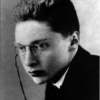Roman Jakobson

Roman Jakobson
Roman Osipovich Jakobsonwas a Russian–American linguist and literary theorist...
NationalityRussian
ProfessionScientist
Date of Birth11 October 1896
CountryRussian Federation
numbers different firsts
At first acoustics attributed to the different sounds only a limited number of characteristic features.
known time verbal
Of course, we have known for a long time that a word, like any verbal sign, is a unity of two components.
coming following instead latter perceived sound sounds
Instead of following one another the sounds overlap; a sound which is acoustically perceived as coming after another one can be articulated simultaneously with the latter or even in part before it.
acute capacity grave image opposition pointed suggest thin
For example, the opposition between acute and grave phonemes has the capacity to suggest an image of bright and dark, of pointed and rounded, of thin and thick, of light and heavy, etc.
above meanings relation sounds structure task throw viewed
The task is to investigate speech sounds in relation to the meanings with which they are invested, i.e., sounds viewed as signifiers, and above all to throw light on the structure of the relation between sounds and meaning.
strictly
From a strictly articulatory point of view there is no succession of sounds.
acoustics sound mystery
Acoustic phonetics, which is developing and increasing in richness very rapidly, already enables us to solve many of the mysteries of sound, mysteries which motor phonetics could not even begin to solve.
running taken giving
The search for the symbolic value of phonemes, each taken as a whole, runs the risk of giving rise to ambiguous and trivial interpretations because phonemes are complex entities, bundles of different distinctive features.
light tasks speech
Speech sounds cannot be understood, delimited, classified and explained except in the light of the tasks which they perform in language.
identity problem classification
It is once again the vexing problem of identity within variety; without a solution to this disturbing problem there can be no system, no classification.
may language
Languages differ essentially in what they must convey and not in what they may convey.
axes two succession
Every linguistic sign is located on two axes: the axis of simultaneity and that of succession.
way sound individual
Now the identification of individual sounds by phonetic observation is an artificial way of proceeding.
mouths remember crossroads
Remember that the pharynx is at a crossroads from which leads off, at the top, the passage to the mouth cavity and the passage to the nasal cavity, and below, the passage to the larynx.